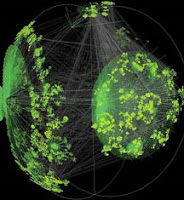Complexity, IPR Rights and Innovation Ecologies
I say unto you: one must still have chaos in oneself to be able to give birth to a dancing star. I say unto you: you still have chaos in yourselves.— Zarathustra
Part 1 — IPR Rights Considerations
In a recent editorial in Science, Bill Wulf used the systems ecology model to frame a forward-looking model for innovation in the life sciences. He defined an “innovation ecology” as the various “interrelated institutions, laws, regulations and policies” necessary to underwrite successful commercialization of publicly funded research through an “infrastructure that entails education, research, tax policy, and intellectual property protection, among others”.
In this formulation, as we have seen increasingly over the last few decades, intellectual property and regulatory (IPR) rights form the linchpin between innovative medical research and the marketing and consumption of approved medical products.
 Notwithstanding the value attached by some to ‘strong’ IPR rights, casting the innovation landscape as an open complex organic ecology rather than a closed historical linear model of basic-to-applied research is consistent with newer more open-ended analytical models such as complex adaptive systems, network dynamics and systems dynamics.
Notwithstanding the value attached by some to ‘strong’ IPR rights, casting the innovation landscape as an open complex organic ecology rather than a closed historical linear model of basic-to-applied research is consistent with newer more open-ended analytical models such as complex adaptive systems, network dynamics and systems dynamics.These 'systems' frameworks view and model systems as dynamic, adaptive and indeterminate networks where the behavior of the system as a whole is governed by the ever-changing and non-linear nature of the connections between actors and institutions rather than as a predictable sum of a set of linear deterministic nodes.
The implications of a systems view of areas of law, such as environmental law, that are strongly contingent on science have been insightfully described by JB Ruhl, including in this blog. Reading over JB’s posts and articles from the perspective of someone who has spent nearly 20 years at the experimental bench prior to entering legal scholarship got me thinking about the value of this approach to the generation of breakthroughs in the life sciences and the policies now being advanced globally for this purpose, particularly those aimed at enhancing domestic productivity and prosperity.
 One implication of a systems view is that smaller domestic innovation ecologies are collapsing globally due among other things to the global reach of patent decisions such as that in KSR v. Teleflex, harmonization of regulatory processes and standards, such as those relating to drug and biologics approval, adoption of international intellectual property instruments such as the WTO's Agreement on Trade-Related Aspects of Intellectual Property Rights (TRIPS) and convergence of national science and technology (S&T) policies aimed at commercialization of publicly funded medical research. Indeed many nations such as my own (Canada) are implementing strong IPR rights regimes that explicitly encompass publicly funded research efforts in order to reproduce the phenomenal success of university technology transfer and commercialization in the United States.
One implication of a systems view is that smaller domestic innovation ecologies are collapsing globally due among other things to the global reach of patent decisions such as that in KSR v. Teleflex, harmonization of regulatory processes and standards, such as those relating to drug and biologics approval, adoption of international intellectual property instruments such as the WTO's Agreement on Trade-Related Aspects of Intellectual Property Rights (TRIPS) and convergence of national science and technology (S&T) policies aimed at commercialization of publicly funded medical research. Indeed many nations such as my own (Canada) are implementing strong IPR rights regimes that explicitly encompass publicly funded research efforts in order to reproduce the phenomenal success of university technology transfer and commercialization in the United States.So, what has complexity theory have to say about the tension between strong ‘closed’ IPR rights on the one hand and more ‘open’ systems of innovation that depend on the inherent creativity and inventiveness of persons skilled in the art (PHOSITA) in an increasingly global product development context? A lot, at least in theory. I will explore this in the second post.












0 Comments:
Post a Comment
<< Home